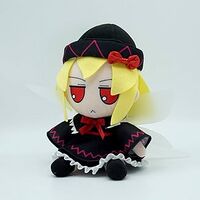Kāichrén Dolls
Kāichrén Dolls, also referred to as (HCL: Chīgenshōga / "Miniature Human Portraits") are a traditional Kāichrén artform. Generally considered to be descendant from ancient Jien dollmaking or sculpture such as the Ishoko, Chīgenshōga were used on a historical level to represent aspects of humanity - and in the modern era are often used for the same purposes, alongside utilization for performance, political critique of the state, and utilization as a children's toy.
History
Early History
Most forms of East Hiakemirian dollmaking are believed to have some level of descent from the Jien Ishoko effigies, a series of figures dated to an approximate 2200BCE (pictured to the right), with their modeling of the human form being an inspiration to other craftsman in regards to their own construction of the human form. The purpose of the Ishoko is somewhat unclear, but most academics believe it was created in relation to other ritualistic devices designed to redirect curses, with the Ishoko being destroyed upon being believed to have absorbed a curse.
The transient nature of the Ishoko despite the somewhat complicated nature of their production would also influence the fashion in which other such creations were treated - and would encourage simplification of designs and some level of mass production even in this early period. The Ishoko would eventually be supplanted by the Sōzō, a funerary monument designed in the shape of the person who had died - by simplifying the human form as expressed in the statue and painting on details afterwards, they could be produced far more easily by less talented designers. An additional benefit was the fashion in which they allowed for larger structures to be constructed using the same template.
Early Modern History
While most dolls would continue to be made out of stone for most of history, this would change rapidly in the Early Sabi period (approximately 1300-1490), owing to the greater production of paper. Both the Teru Teru Bōzu and the Kawakomami were constructions of paper - the former hung for good luck, the latter thrown to the sea to remove evil from the environment they were originally contained within. While these dolls would have the most documentation written about them, it was also in this period that the Kigenist faith would begin having its Utsuwa begin constructing wooden dolls as an act of both meditation and mantling.|
The colonial period would introduce foreign conceptions of dolls alongside plush materials, which would play a major influence on dollmaking into the modern era, despite the best efforts of the State of Kaesong to encourage tradition production of dolls.
Modern History
In the modern era, dollmaking continues to be a notable cultural craft in Neo-Korea, alongside in the Exile-Kāichrén populations located in Meridon. Dollmaking in Neo-Korea proper is primarily used as both a minor "tourist" industry (the transfer of dolls for foreign currency as a memento), domestic utilization by children and performers, and as a culturally rebellious means of incorporating criticism of the state into official performances through media based on dolls. This latter utilization has formed something of a youth culture celebrating such, which some parts of the state (primarily the Shakakukō have eagerly begun to associate themselves with.
Some of Neo-Korea's modern plush dolls (more specifically, the Nuiikon manufactured by the Kaneko-Dezusu Iminchebol) have gained some renown both in foreign nations and internally - owing to their unique design and connection with cultural or video-game based media sources not often celebrated in Neo-Korea. The most notable of the numerous types of Nuiikon are those associated with the Mayonaka Fantajī series of roleplaying games (one example of such depicting one of the minor characters of the franchise is located to the right). The Nuiikon's cultural role is notable enough that, during the visit of Haestia's Mary III to Neo-Korea in 2034, a specialty Nuiikon based on her own appearance was given to her as a gift.
Types
Stone Dolls
- Ishoko-Fukusha: Copied variants of the Ishoko designed by the Kāichrén of the period.
- Sōzō-Fukusha: Copied variants of the Sōzō designed by the Kāichrén of the period.
Wooden Dolls
Paper Dolls
- Teru Teru Bōzu: Small dolls designed to look somewhat similar to Utsuwa, hung outside houses and shrines to give good luck - and used to fulfil the former role even into the modern day. Are additionally a fairly popular visual shorthand to use for the purposes of "outside observers" in a work focusing on some form of metanarrative, owing to Madoka's Narrowing and other work by Kure Yuichi
- Kawakomami: Dolls designed to absorb misfortune before being thrown into a body of water as an act of purification.
Ceramic Dolls
Mechanical Dolls
Plush Dolls
- Niikon: Plush dolls based on notable media franchises or characters, manufactured by Kaneko-Dezusu.
Cultural Significance
Dolls represent a major cultural art of Neo-Korea - acting in many ways to represent parts of the state as a whole, both in a critical sense and in a positive one. Through their connection to the historic progression of art in Hiakemiria, they maintain a connection to cultural and political ideas long abandoned in the rest of the country's development, and in that format are able to provoke questions of if parts of that development were good in the long term for the population.
They additionally provide generally positive memories of youth, which allows the resonance of their existence to be more personal to many members of Neo-Korean society. Their role as a cultural industry also maintains some level of heritage with the shrine-crafting they were initially produced under, although this is a more tenuous connection in the eyes of many modern doll producers.

